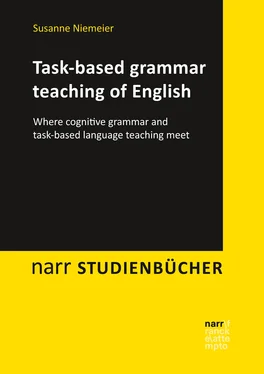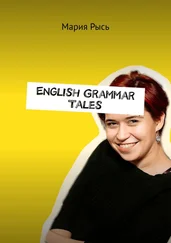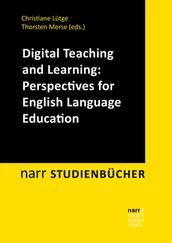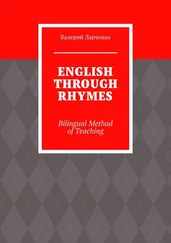Cognitive grammar aims at accounting for all grammatical phenomena by not putting forward arguments about rules and exceptions to these rules but by investigating prototypical usages of a specific grammatical phenomenon as well as its more marginal, but still explainable usages. Compared to other grammatical approaches, this involves a change of perspective for teachers as well as for learners, as cognitive grammar does “not posit a clear borderline between rules and exceptions” but instead refers “to language phenomena as situated within a radial network of meaning with more prototypical instances at the core and more marginal instances on the fringes, all of them related and explainable” (NIEMEIER 2013: 15). Therefore, exceptions to the rule do not have to be learnt by heart anymore but the meaningfulness of marginal category exemplars can be reconstructed via their connection to the prototype. The marginal uses are not seen as arbitrary exceptions but instead as motivated, and therefore as explainable.
Most importantly, from the perspective of cognitive grammar, grammar is meaningful. WIERZBICKA sums up this perspective by stating that
… grammar is not semantically arbitrary. On the contrary, grammatical distinctions are motivated (in the synchronic sense) by semantic considerations, every grammatical construction is a vehicle of a certain semantic structure; and this is its raison d’être, and the criterion for determining its range of use. (WIERZBICKA 1988: 3)
This is why the focus of cognitive grammar is on the motivated, meaningful connections between forms, which are often ignored by other theories of language. Native speakers of a language are presumably not aware of such abstract grammatical meaning, as they use language in a quasi-automatised way. For learners of this language, the situation is somewhat different. They have automatised their own L1, and frequently transfer its grammatical tools to the new language, which in many cases does not work, as different language systems have generally developed different ways of expressing meaning. The further the two languages are typologically apart from each other, the fewer commonalities can be found. However, even in such typologically reasonably closely related languages as German and English the multitude of differences in conceptualization presents quite a challenge for language learners.
Grammar can be seen as a tool in the learners’ hands (and minds) which allows them to articulate their ideas exactly as they want these to be perceived. Language users can actively choose among different forms in order to get their own conceptualizations of given situations or events across to their interlocutors. This active choice goes by the name of ‘construal’, which can be defined as the ability of humans to mentally recreate (or construe) a situation in alternative ways (cf. TAYLOR 2002: 11). For example, the same situation can be presented in various levels of detail, certain participants can be foregrounded or backgrounded (as in the active vs. passive example quoted earlier, cf.page 47), different kinds of words can be used (as in ‘terrorist’ vs. ‘freedom fighter’) and different styles can be applied (as in colloquial use vs. formal use).
To use LANGACKER’s words (2008: 68), “there is no completely neutral way to describe situations – expressions necessarily construe them in a certain manner” as well as from a certain perspective. Furthermore, it is important to mention that a situation frequently does not exactly mirror reality but is a language user’s mental construction, as “much of what we express linguistically is imaginative in nature, even in talking about actual occurrences” (ibid.: 69). For example, when speaking about the picture of a car on a road, it is quite usual to say “the car is driving along a road”. However, the motion of the car is not real but imagined, because the picture only shows the car to be at a specific point of the road. Still, due to their world knowledge, people can predict the movement of the car reasonably well.
The use of figurative language, such as metaphorization and metonymisation, plays a major role in construal. To refer again to the above-mentioned example “the car is driving along the road”, it is obvious that ‘car’ is used metonymically, as it is not the car that is driving but the driver, so the metonymy in question is ‘salient entity for less salient entity’, i.e., the more conspicuous car is mentioned instead of the less conspicuous driver. Metonymy is pervasive in language, even more pervasive than metaphor, as otherwise language would be very redundant and boring. An example for a metaphorical construal is “I spent an hour with my grandmother”, where the verb ‘spend’ has been borrowed from the concrete domain of money in order to provide an understanding of the more abstract domain of time, the underlying conceptual metaphor being TIME IS MONEY. However, the dividing line between metaphor and metonymy is fuzzy, and these two types of figurative language can be imagined to form a continuum (cf. NIEMEIER 2017).
According to LANGACKER (2008: 71), “though generally implicit, these various kinds of mental constructions are crucial to both the form and meaning of expressions. They are facets of an elaborate conceptual substrate that supports and makes coherent the notions overtly expressed”. In other words: speakers frequently leave gaps in what they say, which the listener can fill in, and where the content is not explicitly stated but is only implied. Meaning is not only IN the words or constructions, but additionally needs elaborate mental coding processes (by the speaker) as well as decoding processes (by the listener), in which background knowledge (especially cultural knowledge), experience, memory and other cognitive abilities play an important role.
Many of the standard (or quasi-neutral) construals are language-specific and conventionalised – and “conventional usage almost always has conceptual motivation” (LANGACKER 2008: 72). TAYLOR (2002: 368) quotes the example of the English mass nouns ‘information’, ‘advice’, ‘evidence’, ‘research’ and ‘news’, which in German are count nouns1 (‘Information/Informationen’, ‘Ratschlag/Ratschläge’, ‘Beweis/Beweise’, ‘Forschung/Forschungen’, ‘Neuigkeit/Neuigkeiten’), and which Germans therefore see as countable and thus as being able to add an indefinite article and a plural morpheme. Therefore, these concepts are conventionally seen as structured in different ways by speakers of these two languages. L2 learners frequently carry over their native language concepts into their L2 interlanguage, as they are not aware of the different construals.
Apart from such conventionalizations, construal is additionally influenced by the speaker’s perspective and choice of linguistic items. In an example such as “the apple fell from the tree” vs. “the apple fell on Peter’s head”, two perspectives on one and the same situation are presented, depending on what the speaker deems as more important. In these examples, the source-path-goal image schema is involved. People know from their daily experience that a path starts somewhere (in this case: the fall of the apple started from the tree), continues for a while (in this case: the apple fell through the air), and ends somewhere (in this case: the apple landed on Peter’s head), but not all elements of the source-path-goal schema need to be mentioned, usually one element is enough for the other elements to be intuited. DIRVEN/VERSPOOR (2004: 85) speak of a ‘goal-over-source principle’, meaning that humans are normally more interested in the goal than in the source. But again, this depends on what a speaker wants to focus on – if it is important that the apple fell from the tree (and not from the roof, for example), the focus will be on the starting point. If it is important that the apple landed on Peter’s head (and not on Mary’s, for example), the focus will be on the goal.
Читать дальше












